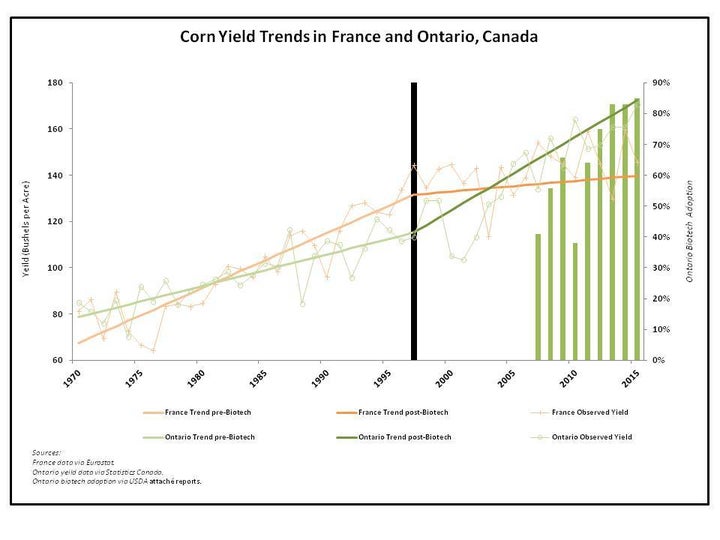
It has now been 20 years since farmers first began using products of ag biotechnology – also known as genetic modification – to grow crops. Not surprisingly, given the significance of the innovation, an immense amount of research has been conducted into the impact.
Many extensive, independent third-party reports have documented the benefits these genetically modified herbicide- and insect- tolerant crops have produced: lower pesticide use, enhanced biodiversity, reduced soil erosion through the facilitation of conservation tillage, stronger bottom lines for farmers and many more. At the same time, critics of the technology have claimed these benefits are exaggerated or are non-existent, and it’s therefore better to avoid it altogether.
Recently I decided to review some research. Knowing how resistant many European countries have been to biotechnology, I decided to investigate how corn yields there have changed in comparison to a place where biotechnology has been embraced. Specifically, I compared the change in corn yields over the last 20 years in France – which boasts the highest corn yields in Europe, but which has shunned GM technology – to those in the Canadian province of Ontario, where the growing environment and corn maturities are similar.
A bit of background first.
The first biotechnology traits in corn were launched in the United States in 1997 by Monsanto with YieldGard® Corn Borer technology. A genetic modification in the plant protected it from damage by worm pests such as corn borers and armyworms. The next year, we launched first Roundup Ready® corn and then corn “stacked” with both Roundup Ready and Corn Borer protection traits in both the United States and Canada. Today, the best-selling corn hybrids in Ontario contain eight different biotech traits: multiple genes to control caterpillars and corn root worms, as well as tolerance traits to several leading herbicides.
Meanwhile, in France YieldGard corn was approved in 1998 and really cultivated in 2005, 2006 and 2007, accounting for maximum 21,000 hectares – a little less than 52,000 acres – in 2007, which was less than one percent of the French corn acreage. At that time, France’s President, Nicolas Sarkozy, effectively triggered its ban through a political compromise he made with the Green lobby. Some people say that, in return for agreeing to prohibit the cultivation of genetically modified crops, Sarkozy got the environmentalists to accept nuclear energy, which today provides more than three-quarters of French electricity.
Now to the data and yield comparison:

It’s clear that the adoption of biotech traits by farmers in Ontario, which now accounts for nearly 85 percent of the corn acres there, correlates closely with accelerated yield improvements. Overall, yields increased from 113 bushels per acre in 1997 to 170 bushels per acre in 2015, an increase of 51 percent. In France during the same period, the increase in yields was only about 10.5 percent.
Picking a single year for a point of comparison can be misleading, however, and in this case it’s especially dangerous, because France had a drought in 2015 while Ontario did not. So to avoid cherry-picking, let’s look at it another way:
France had both higher yields and a more rapid rate of gain than Ontario before the advent of biotech. In the years since its introduction, however, Ontario’s rate of gain has more than doubled while France’s has plummeted. Now Ontario’s yields surpass France’s.
Could other variables account for the difference? No. North American and French corn breeders both use advanced molecular breeding techniques. (Monsanto sells high-performing hybrid corn varieties in both countries, for example.) French, U.S. and Canadian farmers have access to similar crop chemicals, fertilizers, farm equipment and digital agriculture advances.
So the key variable is biotechnology.
Now let’s consider the impact.
If French corn yields had increased at the same rate as yields in Illinois – in the heart of the United States’ most productive corn-growing region, the Corn Belt – France would have produced an estimated 1.5 billion more bushels of corn between 1997 and 2015. Its market value would have been more than $5 billion, based on USDA and Eurostat data. This additional production would have improved farmers’ revenues by almost 10 percent and, of course, reduced foreign grain imports by French feed and food companies. It should be noted that any of the corn and soybeans imported from the Americas which are based on GMO technology are approved for use as food and feed by the European Food Safety Authority (EFSA), the relevant European risk assessment agency.
But there are environmental ramifications as well, which affect not only the French, but all of us.
Like all plants, corn uses photosynthesis to fix carbon. In this process, the corn plant pulls carbon dioxide out of the air and stores the carbon in the grain and in its leaves, stems, and roots – in the rest of its biomass. The higher the corn crop yields, the more carbon is fixed by the plant.
When the grain is harvested, the biomass remaining is stored in the soil or absorbed by soil micro-organisms until the next planting season. Farmers who plow or till their fields to control weeds release a significant portion of the carbon stored in their fields back into the atmosphere. But farmers who employ herbicides and biotechnology help to manage weeds – with herbicide-tolerant crops – can use reduced tillage, or even no-till practices. This means even more carbon can remain in their soil.
The upshot: high-yielding corn acres across the Midwest are becoming net carbon negative – i.e., they’re absorbing more carbon than they emit. In fact, they’re capable of storing about a fourth of the carbon per acre as a hardwood forest. But that’s not happening in France. There greenhouse gas emissions from growing corn are much higher, because not only are yields lower, but farmers are relying much more on tillage and selective chemicals for weed control. This is all the more ironic because some scientists in France recently identified soil carbon as a potential solution to capturing manmade greenhouse gases. This work – aiming at increasing the carbon concentration in soils by 4 per thousand per year - was officially launched by Stéphane le Foll, the Minister of Agriculture himself, at the COP21 meeting in Paris in December 2015.
In France, some farmers do practice no-till farming using glyphosate to control weeds, but they aren’t allowed to grow GM varieties and therefore miss out on the additional environmental benefits of GM crops.
There are other impacts as well. The banning of GMO corn plantings across Europe has effectively eliminated biotechnology research and product advancement in other important European crops, such as wheat, oilseed rape, sugar beet and sunflower. That means European farmers will also miss out on the next generation of even better-performing genetically modified seeds. They’ll miss out as well on the next generation of other biotechnology-based innovations, which will go beyond standard genetic modification to include such advances as microbial seed treatments that improve soil health and powerful new gene-editing methods.
All this matters because the climate is changing and the global population is increasing. A few degrees temperature change not only affects planting dates and crop growth, but also the timing of insect hatches and disease outbreaks. We will need all the tools available to agriculture to mitigate and adapt to climate change and achieve the increases in agricultural production required to meet the demands of the planet leading up to 2050.
In this regard, one other yield comparison should be noted. In both 1988 and 2012, terrible droughts struck large portions of the United States, including my native state of Illinois. In 1988, prior to the introduction of any biotech corn products in the U.S., corn yields there plummeted to 73 bushels per acre. The drought of 2012 was even worse across the state (see here and here), but yields were more than 100 bushels per acre – nearly 50 percent greater. This difference represented more than 300 million bushels of corn – the equivalent of all the production in Texas, Oklahoma and New Mexico.
What accounted for the improvement? Advances in agronomic practices and better corn genetics through genetic modification. The latter helped protect corn plants from feeding damage by corn rootworms and from having their systems for water transport destroyed by burrowing corn borers. And it helped farmers retain moisture in the soil by enabling them to reduce tillage.
To me, all these numbers tell a clear story – of improved food security and a more sustainable environmental footprint through biotechnology.
As it stands, many countries in Europe have chosen to take a different path, promoting organic farming and “agro-ecology.” It’s important to respect everyone’s right to choose what kind of plants they grow and what kinds of food they eat. And as a result, the seed business in Europe is almost entirely focused on traditional, non-GM crops, and this has been the case for many years. I only hope that more and more people begin to see, hear and appreciate the benefits that GM technology offers. Not just to farmers, but also to the environment, which benefits everyone. If that happens, one day decision-makers may finally stop denying their farmers the technology that can help us feed more people and protect our natural resources. Even in France.
